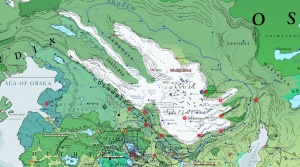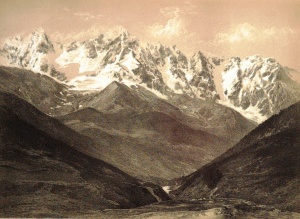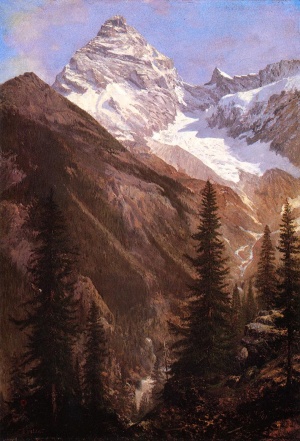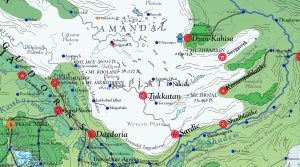Jaggudorn Mountains
The Jaggudorn Mountains belong to either Pytharnia or Asdauria in the minds of Magdeologers (geologists of Asdar). In the hearts and minds of its inhabitants, they lie high above those two flat stretches of the world of Asdar. The Jaggudorns are the highest mountains in the known world and probably the whole world. The highest peak, Mount Jave, reaches a little over 30,000 feet (9140m) above sea level. The Jaggudorns were formed countless ages ago when the subcontinent of Pytharnia slowly merged into the western end of Asdauria, a process that is far from complete. The Jaggudorns present a formidable barrier between the great vale of the Shadew River to the northeast and the forested hills of Pytharnia to the southwest, a barrier which persists in an age of skycraft and titancraft vessels of the air.
The peaks of Jaggudorns are wild and snow-capped all year round. Even the foothills of the Jaggudorns are enormous in comparison to mountains elsewhere in the world of Asdar. Geographically, the Jaggudorns consist of its greatest peaks, the Amandal Plateau and adjoining plateaus, and it high mountain valleys. To northwest of the Jaggudorns stretches the great plain through which the Shadew River flows, bring the meltwater of the Jaggudornish foothils around and south to the Pallathantic Sea.
The eastern valleys are blocked off from sea and have a somewhat dry climate, except when great storms and blizzards blow in from the north, carrying great snows and rains, depending upon the time of the year. In these valleys, the sky tribes of the ancient Gwenyan people developed the technology of vessels of skycraft which would later give them access to the whole western hemisphere. The great valley of Jasturia is also home to sky tribes who lead a hardier existence and continue to subsist on the ancient ways of herding gontha.
Asdarography of the Jaggudorns
The entire complex of mountain ranges known as the Jaggudorns may be seen as many groups of mountain ranges. These mountains may be divided into the very high mountains of the central plateaus and the high "foothill" mountains of the surrounding highland valley plateaus. These mountains are considered 'young' by dwarven magdeologers and are continually uplifted by orogenic forces beneath the earth as the subcontinent of Pytharniaca perpetually collides with western Asdauria.
Mountain Chains of the Jaggudorns
- Aisdir Mountains
- Amandal Jaggudorn Mountains
- Bhinsasa Mountains
- Bloodhammer Mountains
- Dragonheart Mountains
- Greater Jaggudorn Mountains
- Helasundi Mountains
- Helebhuodhi Mountains
- Helemb Mountains
- Olipheimuz Mountains
- Pytharnee Dromb Mountains
- Shankhala Mountains
- Shihalenda Mountains
- Tanisperra Mountains
- Tsakhob'e'el Jaggudorn Mountains
Rivers of the Jaggudorns
The glacial melt of the Jaggudorns feeds several river systems, most notably the Shadew River which accounts for nearly eighty percent of drainage from the mountains to the sea. The Chaosflow River is calculated to be the single largest tributary of the Shadew River. The Lutramani River system drains waters from the western slopes of the Jaggudorns across Pytharnia into the Pytharnian Sea.
List of Rivers of the Jaggudorns
- Tributaries of the Shadew River
- Abristalo River, tributaries: Skleihaspuki River, Igumit River
- Varruzakh River
- Non-Shadevan Rivers
- Andrickar River (non-Shadevan Drainage Basin)
- Sepha River (non-Shadevan Drainage Basin)
Highland Valleys
The highland valleys are much more populated and habitable than the high plateaus of the central Jaggudorns. On the eastern slopes, these valleys are known for the homelands of the skyfaring tribes and to the northeast, the habitation of the Gakhyami, notably the Dagunyami. The Vale of Thrace is the famous homeland of the first skyfaring tribes who in time spread the technology of skycraft throughout the south Jaggudorns, both to the east, west, and south.
High Plateaus
The high plateaus are at least twenty to thirty five dwarven fathoms (3,100m to 5,500m) in elevation. They are very cold in the winter, cold in the spring and autumn, and cool in the summer. They receive less snowfall or rain throughout the year than the highland valleys.
Peaks of the Jaggudorns
The great peaks of the Jaggudorns are a source of pride for its inhabitants and a constant source of death to those who climb them. The locals regard the mountains with awe and reverence and generally do not think well of visitors who dare to reach their summits. Human adherents of the old religion, mountain trolls, and the giants will attempt to stop any human who tries to do so.
Great Peaks of Jaggudorns
- Mount Amandalglow 43.03 DF above sea level, (6926 meters or 22,723 feet)
- Mount Amulcáhain
- Mount Askreidhinn 53.32 DF above sea level, (8582 meters or 28,157 feet)
- Mount Gudhgandin (5680 meters)
- Mount Jave 56.84 DF above sea level, (9148 meters or 30,012 feet) (widely acknowledged as highest place on Asdarah)
- Mount Jhotal 48.28 DF above sea level, (7770 meters or 25,492 feet)
- Mount Kholand 49.48 DF above sea level, (7964 meters or 26,127 feet)
- Mount Thwarren 41.48 DF above sea level, (6676 meters or 21,903 feet)
Flora
Rhododendron plants grow on most mountains. Oak, laurel and chestnut trees are also found up to 11 DF (1800 m or 6,000 feet) above sea level. Pine trees are found up to about 20 DF (ca 3350 m or 11,000 feet) above sea level; above that point only lichens, grass and moss can be found, since it is so cold in the higher regions. Only certain plants are designed to grow in such harsh conditions.
Fauna
While the highest plateaus and peaks are too savage for forestation, the mountain valleys up to mid-elevations are richly forested and where human habitation has not fully encroached upon them are abundant with all manner of wildlife and vegetation. Snowbears, black bears, brown bears, thraughbears, yaks, patchudeeks, bagoose, gamudhs, wolves, wyverns, snow eagles, glambucks, havruts, jadders, wolverines, and wild boars are among the beasts found. The gontha are a domesticated race of cattle indigenous to the Jaggudorns and have been an essential component of the economy since the first sky tribes arrived. There are plenty of marks for the hunter in the Jaggudorns and plenty of predators to turn the table on the hunter.
Bears
Many varieties of bears live in the Jaggudorns. The snowbear is common on the high plateaus. The thraughbear dwells most anywhere, including the high plateaus. The brown bear loves the thick forests and the black bear prefers the woodlands of the lower ranges of the mountains.
Domestic and Commensal Beasts
Gontha are one of the principle domestic animals of humans and humanlikes. The Patchudeek are great yak-like creatures bred among the Jaffgorns and used as pack animals and sometimes for food.
History of the Jaggudorns
Inhabitants
The Amandal Plateau, especially in the north, is the habitation of mountain giants, frost giants, mountain orcs, ogres, trolls, goblins, and a host of other inhospitable creatures. The Jaffgorn, a race of Geddamin (giants) occupy many of the high mountain valleys of the northern Amandal Plateau and hold much political and economic power over the northern interior of the plateau. Foul humanlikes such as goblinoids and orcs are common in the northernmost Jaggudorns along with a smattering of dragon lairs. Traveling in the northern Jaggudorns is dangerous even for the hardiest adventurers. The mountains and their savage residents have no mercy for visitors. The northeastern Jaggudorns are famous for their races of goblins or Gakhyami, consisting of the Umyami, the Uglyami, Ruyaks, and the Dagunyami.
The southern Jaggudorns are more populous with fauna, flora, and humanlikes, affording a less harsh haven, especially in the rich, high alpine valley of the Shadmaus. The ancientest dwarves make their subterranean homes in the Jaggudorns and they are known as the Amandal Dwarves. In the south-southwestern Jaggudorns are several dwarven states and their ancestors have dwelt for millennia. Forest-dwelling Shadevan Trolls are common in the Shadmaus, often living just a stone's throw from small human settlements.
List of Known Humanlikes of the Jaggudorns
- Dwarves
- Gakhyami (Dagunyami, Uglyami, Umyami, Ruyak)
- Humans
- Jaffgorn Giants
- Mountain Ogres
- Mountain Orcs
- Shadevan Trolls
- Tubbakese Halflings
Dwarves of the Jaggudorns
Dwarves have held a habitation in the Jaggudorns for over fifteen thousand years. The Qaish'aa dwarves from the Ithrads are considered newcomers by dwarven standards. Nevertheless dwarven culture in the Jaggudorns is well adapted to the hazards both above and below the surface. On the high plateaus, the most common dwarves encountered are the Amandal Dwarves, particularly in the south. In the high valleys of the southwest, the Qaish'aa Dwarves of Gdelisica, Themet, Dagdoria, and Sardeichs may be found.
Amandal Dwarves
The indigenous Amandal dwarves of the plateau regard the other dwarves of the Jaggudorns as newcomers, even though the first ancestors of the later Qaish'aa Dwarves immigrated here thousands of years ago. Dwarven monasteries are not uncommon in the southern Amandal Plateau. In these highest of mountain valleys, the Amandal dwarves commune with cosmic forces alien to other members of their kind. Their spiritual insights are sought by pilgrims and visitors from elsewhere in the world of Asdar. They are peaceable but fierce against human, dwarven, and giant foes.
Midrardian Dwarves
Over eleven thousand years ago, dwarves migrating from Midrardia, sometimes called Qaish'aa dwarves, settled in the mountains of south central Pytharnia known as the Ithrads. In time, colonies of these dwarves migrated eastwards and settled in the depths of the southwestern Jaggudorns. The language of these dwarves is very similar and mutually intelligible.
The dwarven states of Themet, Gdelisica, Dagdoria, and Sardeichs are highly industrialized with titancraft and other technologies. They are abundant in mineral wealth as the dwarves have plumbed the depths of the mountains since the time they first dug their holes into the mountain slopes. Their treasures include gold, silver, iron, copper, and a constellation of gemstones and semi-precious stones. The dwarves have created a huge, subterranean network of dragonrail throughout the southern Jaggudorns. Only in the past one hundred and fifty years have the dwarves shared their technology with humans on the surface to the furtherance of dwarven commerce throughout Pytharnia and the rest of the world.
Over four thousand years ago, a cousin group to the Ithradic dwarven settlers, sometimes called the 'Mountain Dwarves' also fled Midrardia and settled in the north Jaggudorns, founding the colony Eingred.
Economy
The Grand Shadew Canal has provided a great means of economic development of the High Shadevan Valley, particularly for Thrace which exports a surplus of grain to the food-hungry nations of the Pallathantic. Gontha are shipped in river-barges to the Pallathantic where they are slaughtered for meat.
Politics
In the south are found all the sky nations since the Reduction of Thrace in 2576 and all the dwarven states. These are the states of Thrace, Gantvia, Jamenth, Shaddago, and Hamalan. The dwarven states are the Amandal Republic, the Kingdom of Themet, the Commonwealth of Gdelisica, the Kingdom of Dagdoria, and the little Commonwealth of Sardeichs tucked up on the south end of the Amandal Plateau. The Aurician Empire controls most of the rich Shadmaus, a high mountain valley that bears the Shadew River on its last descent to the Shadevan Delta. The Shadmaus has a rich folklore and its woods are home to trolls of a gentler nature. The Shadew River has been tamed by the Aurician Empire with the construction of the Five Locks enabling huge cargo barges to carry grain from the High Shadevan Valley past the cataracts of the Shadew River into the Pallathantic Sea.
Flags of States of the Jaggudorns
Commonwealth of Thrace, Civilian
Commonwealth of Thrace, Military
See Also
- Amandal Dwarves
- Amandal Plateau
- Asdauria
- Chronology of the Jaggudorns
- Gakhyami
- Gontha
- High Shadevan Tribes
- Pytharnia
- Thrace
| Antarctica | Asdauria | Barathorn and Orrhymby | Danona | Pallathantic Sea | Pytharnia | Sungo | Two Bahunas |
|---|---|---|---|---|---|---|---|
|
Deepearth
|
|
Major Isles
Major Isles Minor Isles |
Deepearth |
Template:List of Mountain Chains of Asdar
| This article is a stub. It requires further development by the creator. |











